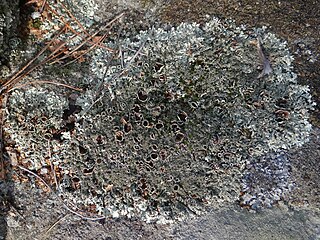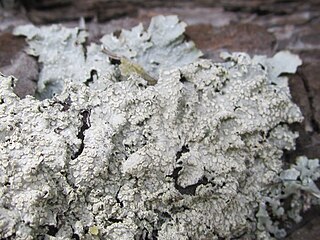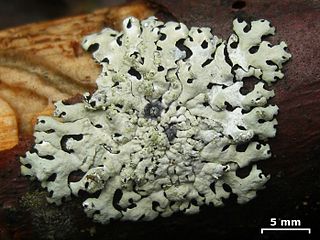
Pseudevernia is a genus of foliose lichens in the family Parmeliaceae. The type species of the genus, Pseudevernia furfuracea, has substantial commercial value in the perfume industry.

Flavoparmelia is a genus of foliose lichens in the family Parmeliaceae. Because of their appearance, they are commonly known as greenshield lichens. The widely distributed genus contains 32 species. It was circumscribed by American lichenologist Mason Hale in 1986 to contain 17 former Pseudoparmelia species with broad lobes, usnic acid in the cortex, and isolichenan in the cell walls.

Xanthoparmelia is a genus of foliose lichen in the family Parmeliaceae. Xanthoparmelia is synonymous with Almbornia, Neofuscelia, Chondropsis, Namakwa, Paraparmelia, and Xanthomaculina. This genus of lichen is commonly found in the United States, as well as Australia, New Zealand and Ecuador.
Psiloparmelia is a genus of lichen belonging to the family Parmeliaceae. It contains 13 Southern Hemisphere species, most of which are found growing on rocks at high elevations in South America. There are several characteristic features of the genus that are used to distinguish it from the morphologically similar genera, such as Arctoparmelia, Flavoparmelia, and Xanthoparmelia. These include a dark, velvety lower thallus surface that usually lacks rhizines, a negative test for lichenan, and a high concentration of usnic acid and atranorin in the cortex.

Xanthoparmelia mougeotii is a species of foliose lichen belonging to the family Parmeliaceae.

Xanthoparmelia conspersa, commonly known as the peppered rock-shield, is a foliose lichen and the type species of genus Xanthoparmelia. It is widely distributed in temperate zones, and has been recorded from Japan, Europe, Africa, North America, and South America.

Xanthoparmelia scabrosa, jocularly known as sexy footpath lichen or sexy pavement lichen, is a foliose lichen in the family Parmeliaceae. It tolerates a very wide range of substrata, predominantly rock but also tree bark, roofing tiles, glass, and in wetter areas bitumen paths and roads.
Arctoparmelia separata, commonly known as the rippled ring lichen, is a species of foliose, ring lichen in the family Parmeliaceae with a roughly circumpolar distribution.

Xanthoparmelia lineola, commonly known as the tight rock-shield, is a foliose lichen species in the genus Xanthoparmelia. It is a common species with a temperate distribution. Found in North America and South Africa, it grows on rocks.
Bulbothrix meizospora is a species of foliose lichen in the family Parmeliaceae. It is found in Africa, Asia, and South America, where it grows on tree bark.
Punctelia subpraesignis is a species of foliose lichen in the family Parmeliaceae. It occurs in Mexico, South America, and East Africa, where it grows on bark and on rocks. Major characteristics of the lichen that distinguish it from other Punctelia species include the C+ and KC+ rose spot tests of the medulla, ascospores that are smaller than 20 μm, and unciform (hooklike) conidia.

Punctelia punctilla is a species of foliose lichen in the family Parmeliaceae. It is found in Africa, South America, and North America, where it grows on bark and on rocks. The main characteristics that distinguish Punctelia punctilla from other species of Punctelia are the presence of isidia on the thallus surface, a pale brown thallus undersurface, and the presence of lecanoric acid in the medulla.

Punctelia perreticulata is a widely distributed species of foliose lichen in the family Parmeliaceae. It occurs in Mediterranean Europe and Russia, North America, South America, Australia, and New Zealand, where it grows on rocks, bark, or wood. Its main distinguishing features are its thallus surface, marked with many shallow depressions, grooves, or pits, and sorediate pseudocyphellae. The lower side of the thallus is ivory to tan towards the centre and the major secondary metabolite in the medulla is lecanoric acid. A lookalike species with which it has been historically confused is Punctelia subrudecta; this lichen can be distinguished from Punctelia perreticulata by the texture of the thallus surface, or, more reliably, by the length of its conidia.
Xanthoparmelia kalbii is a species of foliose lichen in the family Parmeliaceae. Found in Brazil, it was described as a species new to science in 1984 by American lichenologist Mason E. Hale. The type was collected in Catimbau National Park in Pernambuco. The specific epithet honours Klaus Kalb, "the first professional lichenologist to collect extensively in Brazil since G. A. Malme in the 1890s".
Menegazzia tarkinea is a rare species of foliose lichen in the family Parmeliaceae. It occurs in North West Tasmania (Australia).
Xanthoparmelia isidiovagans is a species of foliose lichen in the family Parmeliaceae

Hypotrachyna osseoalba, commonly known as the grainy loop lichen, is a species of foliose lichen in the family Parmeliaceae. It is widely distributed in subtropical and temperate areas of the world. Characteristic features of the lichen include the pustules in its cortex, the somewhat linear shape of the lobes comprising the thallus, and the branched rhizines.
Phacopsis australis is a species of lichenicolous (lichen-dwelling) fungus in the family Parmeliaceae. It is found in a few locations in South Africa, where it grows on the thalli of several species of the leafy lichen genus Xanthoparmelia. Unlike other members of genus Phacopsis, the fungus does not induce the formation of galls in its host.
Xanthoparmelia waboomsbergensis is a species of foliose lichen in the family Parmeliaceae. It was formally described as a new species in 2002 by Australian lichenologist John Elix. The type specimen was collected from the summit of Waboomsberg mountain at an altitude of 1,220 m (4,000 ft). The species epithet refers to the type locality, the only place the lichen is known to occur.
Xanthoparmelia perezdepazii is a species of saxicolous (rock-dwelling), foliose lichen in the family Parmeliaceae. It is found in the Canary Islands.









